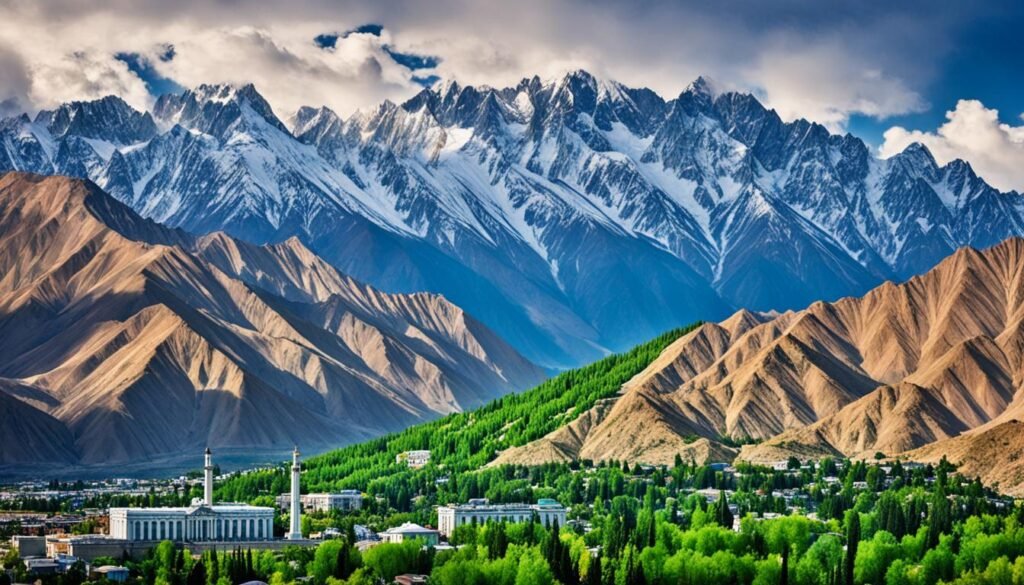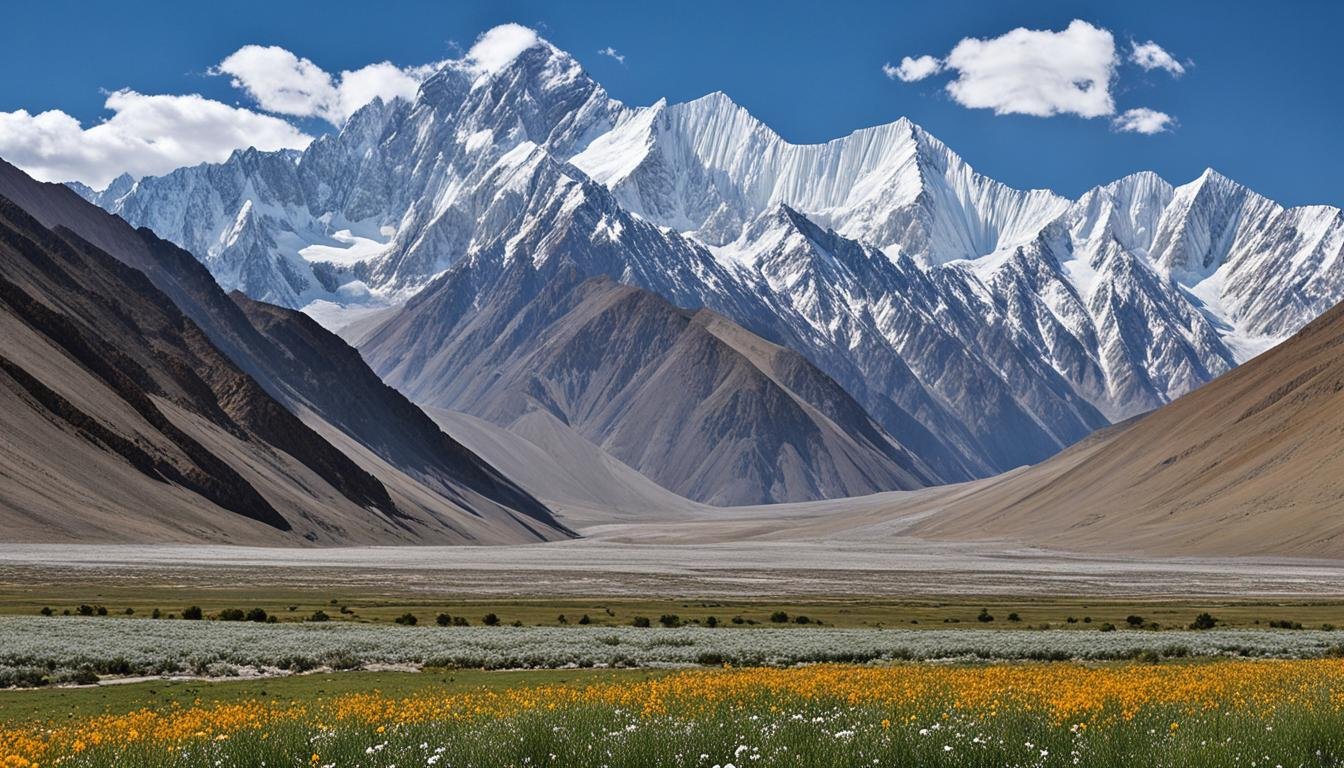Tucked away in the heart of Central Asia, the mountainous landscapes of Tajikistan are a testament to the region’s breathtaking natural beauty and ecological significance. In fact, a staggering 93% of Tajikistan’s territory is covered by mountains, with the Pamir Mountains and the Gorno-Badakhshan Autonomous Region serving as the epicenter of this captivating high-altitude environment. These vast, untouched alpine ecosystems along the historic Silk Road not only captivate the senses but also play a vital role in the resilience and livelihood of the region’s communities.
Key Takeaways
- Tajikistan is a mountainous country, with 93% of its territory covered by mountains, including the Pamir Mountain range.
- The Pamir Mountains and the Gorno-Badakhshan Autonomous Region are home to breathtaking, untouched alpine ecosystems along the historic Silk Road.
- These mountain ecosystems are essential for the resilience and livelihood of the region’s communities, providing vital freshwater resources and supporting diverse flora and fauna.
- The mountains of Tajikistan serve as the center of origin and diversity for many globally significant fruit and nut tree species.
- Protecting and sustainably managing these mountain environments is crucial for the long-term well-being of the region’s people and ecosystems.
Breathtaking Mountain Ranges Along the Silk Road
Tajikistan, nestled within the Central Asian mountains, boasts a breathtaking array of landscapes that have captivated travelers along the historic Silk Road for centuries. These untouched, pristine mountain ranges, such as the Pamir Mountains, offer a stunning backdrop to the region’s rich cultural heritage and serve as vital ecosystems for the local communities.
Captivating Landscapes and Untouched Beauty
The Central Asian mountain landscapes of Tajikistan are renowned for their captivating and untouched beauty. Towering peaks, glaciers, and lush valleys create a visual tapestry that is both awe-inspiring and serene. These mountain environments, largely undisturbed by human activity, provide a rare glimpse into the natural wonders of the region.
Essential for Regional Resilience and Livelihood
Beyond their breathtaking aesthetics, the mountain ranges of Tajikistan play a crucial role in the region’s resilience and the livelihoods of local communities. The glaciers in these mountains hold vast quantities of freshwater, providing a vital supply for 90% of the population in the region. These mountain landscapes are also recognized as the center of origin and diversity for many globally significant fruit and nut tree species, highlighting their importance for the region’s ecology and agriculture.

Glacial Water Sources and Ecosystem Diversity
The Central Asian mountains, including Tajikistan, are home to vast glaciers that serve as critical water reservoirs for the region. These glaciers hold an abundance of freshwater, which flows downstream to nourish rivers and sustain the livelihoods of over 90% of the local population. Tajikistan’s communities are heavily dependent on this glacial water for their households, agricultural activities, and overall economic well-being.
Vital Freshwater Supply for Communities
The glaciers in Tajikistan and the broader Central Asian mountains play a vital role in providing a reliable freshwater supply to the region. This water is essential for supporting the diverse ecosystems, agricultural production, and the daily needs of the local populace. The meltwaters from these glaciers feed into the intricate network of rivers, ensuring a steady flow of water throughout the year, even during the dry seasons.
Center of Origin for Fruit and Nut Species
Remarkably, the Central Asian mountains, including Tajikistan, are recognized as the center of origin and diversity for numerous globally significant fruit and nut tree species. This includes apples, grapes, walnuts, and other cultivars that have been cultivated and consumed in the region for centuries. The region’s unique climate and topography have fostered the development of this rich genetic diversity, highlighting the importance of preserving Tajikistan’s mountain ecosystems for their global significance in food production and biodiversity.

Tajikistan: Central Asian mountain ecology Dushanbe Tajikistan
Nestled in the heart of Central Asia, Tajikistan’s mountainous regions, including its capital city Dushanbe, are an integral part of the region’s rich mountain ecology. These high-altitude environments and alpine ecosystems play a crucial role in the resilience, water resources, and biodiversity of the entire area.

The Tajik mountains, part of the broader Central Asian mountain range, are renowned for their captivating landscapes and untouched beauty. These rugged peaks and valleys are not only visually stunning but also essential for the region’s livelihood and ecological balance. The mountain ecosystems in Tajikistan provide vital freshwater sources, sustain diverse flora and fauna, and serve as a center of origin for various fruit and nut species.
Dushanbe, the capital city of Tajikistan, is situated at the heart of this rich mountain ecology. The city’s proximity to the surrounding highlands allows its residents to closely interact with and depend on the natural resources and services provided by the mountain environment. Understanding and preserving the delicate balance of Tajikistan’s mountain ecology is crucial for the long-term sustainability and resilience of the region’s communities.
Land Degradation: A Costly Threat
In the rugged landscapes of the Central Asian mountains, including Tajikistan, increased human activities such as expanded agriculture, logging, and pastoral practices have taken a toll on the land. This land degradation, marked by erosion and loss of vegetation cover, has had a significant economic impact on the region.
Economic Impact of Productivity Loss
Studies have found that land degradation in the Central Asian mountains, on average, costs the countries in the region 4% of their GDP. In Tajikistan, the economic consequences are even more stark. It was estimated that land degradation in the country’s mountainous regions cost between $539 million and $950 million in 2019, equivalent to 8.1% and 13.4% of Tajikistan’s GDP, respectively.
This substantial economic impact is a direct result of the loss in land productivity, which undermines the livelihoods and incomes of the communities that rely on the land for their sustenance and economic wellbeing. The degradation of Tajikistan’s Central Asian mountain ecosystems poses a severe threat to the country’s development and prosperity.
Climate Change and Natural Disasters
Tajikistan, nestled in the heart of the Central Asian mountains, is grappling with the profound impacts of climate change. The region’s breathtaking landscapes, once pristine and untouched, are now facing the brunt of glacier melting and extreme weather events. As global temperatures rise, the delicate balance of these high-altitude ecosystems is disrupted, leading to a cascade of natural disasters that threaten the very fabric of mountain communities.
Glacier Melting and Extreme Weather Events
The glaciers that have long been the lifeblood of the Central Asian mountains are receding at an alarming rate, a direct consequence of climate change. This rapid glacier melting not only disrupts the vital freshwater supply for local communities but also increases the risk of devastating floods, landslides, and mudflows. Furthermore, the region has witnessed a surge in the frequency and intensity of extreme weather events, such as heavy rainfalls, heatwaves, and severe storms, further exacerbating the challenges faced by these fragile mountain environments.
Cascading Hazards in Steep Valleys
The steep, rugged terrain of the Central Asian mountains, including Tajikistan, is particularly susceptible to cascading hazards. A single disaster, such as a landslide or a glacial lake outburst, can trigger a domino effect, leading to secondary and tertiary hazards that multiply the devastation. These cascading events, fueled by climate change, have already taken a significant toll on the region, affecting the lives of millions and causing billions in economic losses. Addressing these complex, interconnected challenges is crucial for the resilience and sustainability of Tajikistan and the broader Central Asian mountain ecosystem.

Vulnerable Mountain Communities
In the heart of Central Asia, the communities living in the rugged Tajikistan mountains face unique challenges. These vulnerable populations often reside in secluded areas with limited access to essential infrastructure and basic services. Marginalization and a lack of political attention have exacerbated their struggles to adapt to the growing threats of climate change and natural disasters.
Marginalization and Lack of Access
The remote mountain villages in Tajikistan and the wider Central Asian region are frequently overlooked, receiving disproportionately less public investment and government support compared to other parts of the country. This marginalization has left these vulnerable communities with inadequate access to healthcare, education, and economic opportunities, hindering their ability to build resilience and cope with the mounting challenges they face.
The rugged terrain and lack of connectivity have further isolated these communities, cutting them off from essential resources and emergency response services. This lack of access has made them particularly susceptible to the impacts of extreme weather events, glacial melt, and other climate-related hazards that threaten their livelihoods and safety.
Addressing the needs of these vulnerable mountain communities in Tajikistan and the broader Central Asian region is crucial for building a more equitable and resilient future. Investing in infrastructure, improving access to basic services, and empowering local leaders can help these marginalized populations overcome the unique challenges they face and adapt to the changing environmental landscape.
RESILAND CA+ Program for Landscape Restoration
Recognizing the critical role of Tajikistan’s Central Asian mountain ecosystems in fostering regional resilience, the World Bank has designed the innovative RESILAND CA+ Program. This ambitious initiative reflects the unified vision and collaborative efforts of Central Asian leaders to enhance the resilience of cross-boundary landscapes across the region.
The RESILAND CA+ Program aims to invest in the restoration of these valuable landscapes, which can unlock a range of benefits for local communities. By revitalizing degraded lands, the program seeks to boost agricultural productivity, create green jobs, promote ecotourism, and build more resilient infrastructure. Ultimately, these efforts will sustain and transform the livelihoods of people living in Tajikistan’s mountain regions.
Through strategic partnerships and targeted interventions, the RESILAND CA+ Program is poised to be a game-changer in the region. By harnessing the power of landscape restoration, this innovative initiative promises to unlock the full potential of Tajikistan’s Central Asian mountain ecology, fostering a more sustainable and resilient future for all.
Disaster Risk Management and Early Warning Systems
In Tajikistan, home to the majestic Central Asian mountains, the World Bank is actively engaged in enhancing disaster risk management capabilities. This crucial initiative aims to improve climate, water, and weather forecasting services through the Central Asia Hydrometeorology Modernization Project. This investment is particularly vital as farmers in the region rely on their ability to protect their assets from the threats of droughts, storms, and extreme temperatures.
Accurate forecasts and early warning systems are essential for public disaster management agencies to determine when to issue timely alerts, enabling communities to prepare for and respond effectively to potential natural disasters. By strengthening these climate and weather forecasting services, the World Bank’s efforts in Tajikistan are helping to safeguard the livelihoods of those who call the Central Asian mountains home.
The region’s vulnerability to the impacts of climate change, including glacier melting and the increased frequency of extreme weather events, underscores the critical importance of these disaster risk management initiatives. Investing in resilient infrastructure and empowering local communities to adapt to the changing climate is a key focus of the World Bank’s work in Tajikistan and the broader Central Asian landscape.
Regional Cooperation and United Approach
Tajikistan’s commitment to fostering regional cooperation in Central Asia has been instrumental in addressing complex challenges related to water and climate change. The High-level Central Asian Forum on ‘Water and Climate Change’, organized by the United Nations Development Programme (UNDP) in partnership with the European Union and the Ministry of Energy and Water Resources of the Republic of Tajikistan, has become a cornerstone of the 3rd High-level International Conference on the International Decade for Action “Water for Sustainable Development” 2018-2028.
High-level Central Asian Forum on Water and Climate Change
This influential forum has facilitated vital discussions among government representatives, development partners, and stakeholders from Kazakhstan, Kyrgyzstan, Tajikistan, Turkmenistan, and Uzbekistan. The focus has been on improving water and climate dialogue, implementing risk-informed policies, and enhancing regional cooperation on water resource management and environmental protection in Central Asia.
Transboundary Water Cooperation and Resource Management
By fostering transboundary water cooperation and effective resource management, Tajikistan has demonstrated its commitment to addressing the interconnected challenges of water and climate change in the region. This collaborative approach has been crucial in ensuring sustainable development and strengthening the resilience of communities across Central Asia.
Conclusion
The mountain ecology of Tajikistan and the broader Central Asian region is a complex and interconnected system facing myriad challenges. From land degradation and climate change to natural disasters and the vulnerability of mountain communities, the path forward requires a comprehensive and collaborative approach. However, through initiatives like the RESILAND CA+ Program and the High-level Central Asian Forum on Water and Climate Change, the countries of Central Asia are poised to address these pressing issues.
By investing in landscape restoration, improving disaster risk management, and fostering regional cooperation, the region can work towards a more resilient and sustainable future for its mountain environments and the communities that depend on them. The delicate balance of the Tajik and Central Asian mountain ecosystems is essential for the well-being of the entire region, from the vital freshwater supplies to the center of origin for fruit and nut species.
As the countries of Central Asia unite in their efforts to protect and enhance this invaluable natural resource, they can pave the way for a future where the breathtaking mountain ranges along the Silk Road continue to captivate and sustain the people who call this region home. Through a united approach and a commitment to regional cooperation, the promise of a more resilient and prosperous Central Asia can be realized.
Source Links
- Protecting Central Asia’s mountains and landscapes to transform people’s lives and livelihoods – https://blogs.worldbank.org/en/europeandcentralasia/protecting-central-asias-mountains-and-landscapes-to-transform-peoples-lives
- Central Asian States Rally for Water and Climate Solutions – https://www.undp.org/tajikistan/press-releases/central-asian-states-rally-water-and-climate-solutions
- Diversity of Plants and Animals in Mountain Ecosystems in Tajikistan – https://journals.iau.ir/article_512968.html


